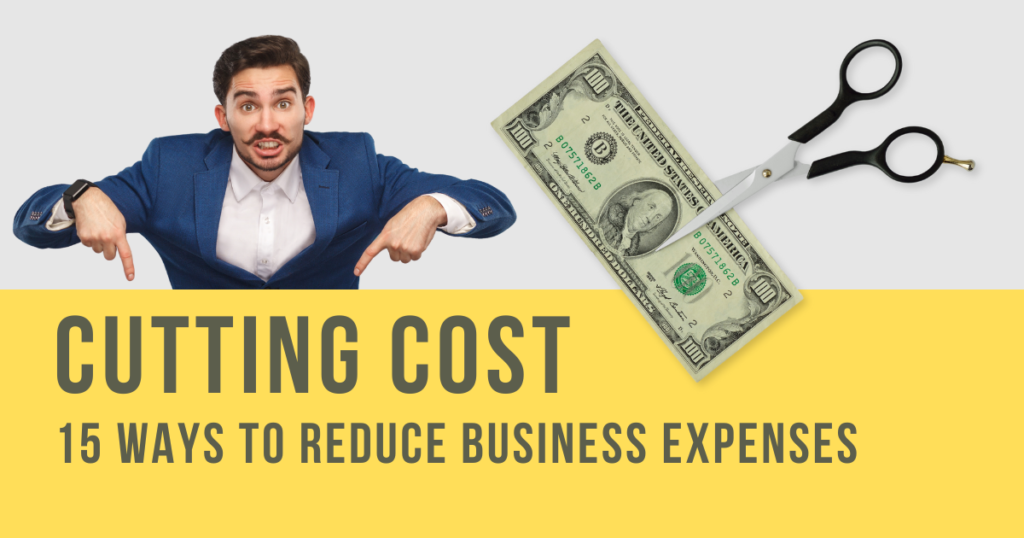Table of Contents
Cutting costs within your business can take many forms. Reducing business costs can take place at various stages of a business development (early on when costs need to be controlled, mid-way through when the organization needs capital to help it mature or at the later stages of its development when the organization needs to innovate to survive). Whatever the reason for this need to reduce costs, there are many ways in which this can be secured. The key here is to be clear about what it is you are seeking to reduce, how you want to reduce it and why.
To help you reduce costs, you may call upon a contractor, a consultancy company or internal stakeholders that have been involved with such efforts before. Equally, you can take ownership of these efforts yourself (as an individual, a department or a business) using the advice as set out in this article and others.
In this article, we are going to explore the different categories of business cost reduction you may explore and the various options you’ll find inside each of them.
Cutting costs: Reducing Compensation Costs

- Offshore work to a lower cost location. If you currently operate from a high-cost location (UK, US, EU etc.) you may be able to explore moving certain activities overseas. These should not just be certain activities, as that won’t actually reduce costs. You want to move whole processes, departments and operations (overtime) to lower-cost locations.
- Automation. Similarly, automating entire processes or operations could be an option. From an operational perspective, this would of course need to be staggered, but you can get the ball rolling today. Automating activities, processes and eventually whole roles can lead to significant reductions in cost.
- Automate handoffs & middle people. Building good connectors and integrations between systems and processes is also a great way to reduce costs. Organizations often have to hire people to operate within the middle of operations and between processes to get work done and projects moved forward – automating those activities can save you a lot.
- Restructure the department. Conduct an end-to-end review of your operations including the people that work within them, the roles they play and where they are placed. Restructuring efforts, no matter how small or large can lead to significant savings, with roles either reformed or totally removed.
- Merge departments and roles. Conduct a similar review to ensure the roles people are doing are a genuine value add (you’ll be surprised how many actually are not). Equally, understand how much scope there is to cross-train across teams and departments. Such work typically always leads to a reduction in costs (2 teams total 20 becomes 1 team totalling 15).
Cutting costs: Optimizing Third-Party Expenses

- Change your contract approach. When looking to negotiate new contracts with any providers going forward, have a newly agreed contract approach. These contracts could include standard ones, fixed-term ones, reward ones etc. Set that expectation to see the costs of future contracts reduced, plus negotiating times.
- Change current contracts. If possible, seek to open up negotiations with your current 3rd party providers (for whatever service) and give them options to negotiate. This could include an extended partnership but for a more mailable and flexible contract which can see costs go down where needed.
- Tier cost your requirements. For those functional requirements, you can pay the expected or market rate. For those additional, non-functional requirements, you could seek to pay less or, remove them from agreements altogether.
- Get involved in beta testing. If you work with any organizations that are testing new approaches, systems or modules, seek to get involved with these early. Having long-standing relationships helps here, and you can often get cool new additional features initially free.
- Change provider. It may be the case, that once you have assessed the market, you find a provider who can provide the same or more for less.
Cutting costs: Efficient Equipment Management

- Task procurement to find cheaper alternatives. As part of a wider effort, you could ask your Procurement Team to find cheaper alternatives in the market. This reduces the need for you or the team to do this, and they can come back with the results.
- Change loss & damage policies. Once generous policies surround the loss or damage of equipment could be toughened up. This not only discourages recklessness (and reduces the cost of replacing the equipment) but also means some of the lost monies could be potentially recouped as per the new policy.
- Outsource maintenance. If you have internal maintenance that needs to root cause, solve for and fix the various problems that occur, you could seek to outsource this. This would mean that if there are increased costs at any time due to more loss, damage or theft, the internal costs do not change. The outsourced contract is agreed upon and fixed.
- Change supplier. If you are going to continue to have high equipment turnover, loss, damage or theft, finding a cheaper supplier of the products could also be an option. Here, buying in bulk and being supplied as such will be cheaper overall and in the shorter and longer terms.
- Change wider equipment policies. This could include reducing the number of people who have access to a company mobile or tablet device, reducing those who can have work-from-home additional equipment (second screens) or putting additional equipment spending on company accounts.
Cutting costs Conclusion
When it comes to reducing the cost of doing business, there are a number of areas you can target. The above are just a sample of these, but there are many more. The key here is to define what you want to achieve well, identify the right approach to achieve this and deliver on those aims. You need to engage with your leaders and the wider business to understand what they want and why. The efforts we have just discussed will vary in impact, with some being able to save thousands of dollars over the short term and others having the potential to save hundreds of thousands of dollars long term. Cutting costs today can help reduce the need for cutting costs tomorrow.
Also read: 10 certain ways to reduce business costs







